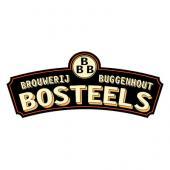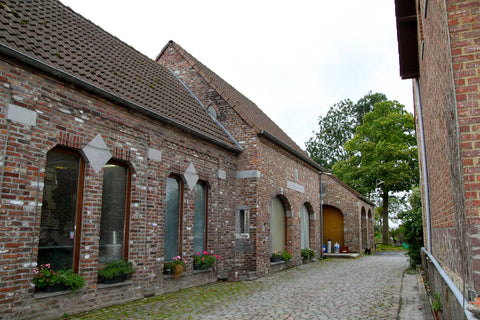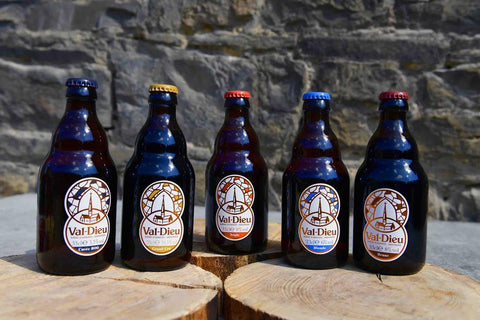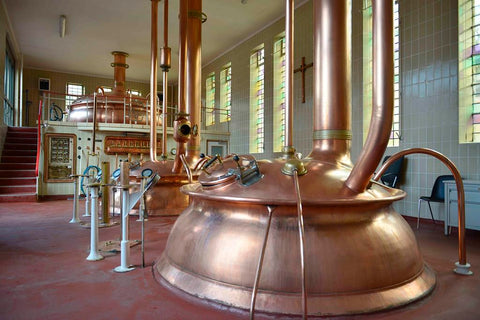- No products in the cart.
Brouwerij Bosteels

The Beginning - The Bosteels brewery oozes grandeur as the stately brewer’s home awaits the arrival of the carriage driver. The brewery has been in the hands of the Bosteels family for over 200 years. In 1791, Evarist Bosteels started brewing in Buggenhout.
Jozef, Martin, Leon, Antoine, Ivo and Antoine Bosteels followed his trail and walked in his footsteps for seven generations.
Family history is closely intertwined with local politics. Frans, the son of Jozef, held the position of Mayor of Buggenhout for 13 years.
Antoine Bosteels, grandfather of Antoine, the current manager, was in charge of the brewery for half a century. He was also appointed Mayor a number of times.
The handsome brewery mansion (1859) was designed by architect Louis Minard (1801-1875), known for the Minard Theatre in Ghent. Everything here breathes style and class. In the corridors the sun peeps through stunning leaded glass windows with resplendent images of mashing sticks and flourishing hop plants.
There is no doubt that a brewer lives here. In the stately reception room the harpsichord is awaiting the first notes of a waltz.
The carriages wait for their passengers in the courtyard. It won’t be long before the coach driver clicks his tongue and the horses take us swiftly through the Scheldeland region. The Bosteels brewery has a thing with carriages. Pauwel Kwak is a carriage beer with a lovely story attached to it. In the 18th century, brewer Pauwel Kwak from Dendermonde owned an inn which was a regular stop for mail coaches.
However, the drivers were not allowed to leave their coach and horses alone and were thus prohibited from enjoying the Kwak, then a very popular beer in the region.
Undeterred, the brewer found a solution. He commissioned a ‘suspended glass’, which is still in use today and was designed to be easy to fix to the sides of the carriage. Nowadays the brewer may ride out in his carriage and hear the Kwak glass tinkle.
His suspended glass is obviously part of the procedure. The beer is poured into this special glass with its wooden support as the Kwakglas is concave and cannot stand on its own.
The Brewing

The Bosteels beers are hard to categorise. The brewer has opted to go into three very different directions: an amber beer, a tripel using various types of grain, and ‘grain bubbles’. All three are complex beers, far from extreme and not too heavy, but the taste is what they have in common. These beers deserve all the attention they get.
The brewer much prefers to offer three beers that he has developed to perfection than to brew a wide range of mediocre beers.
The Bosteels brewery uses soft-ish water drawn from a well that is 60 metres deep and each beer has its own specific yeast. The historic beer, the Kwak, re-launched in the 1970s, is an amber-coloured, Belgian high fermentation beer to which three types of malt are added as well as candy sugar. This results in a slightly malty aroma as well as a fruity taste. The pale wood on which the glass rests forms a beautiful contrast with the beer. Taste a Kwak and the malt will be the first of many aromas to reach your taste buds.

It took three years to create and perfect a special ‘three grains’ tripel, much like a multi-grain loaf.
The beer was born when Antoine Bosteels happened to browse through a publication from the local Dendermonde historical society on the subject of breweries that had disappeared from the area.
His eye fell on the ancient recipe, dated 1679, from the former Carmelite abbey in Dendermonde. The law courts now stand on the site of this ancient abbey. But Bosteels use more or less the same historic proportions of barley, wheat and oats to perfect their ‘three grains’ beer.
With the Tripel Karmeliet you will find the emphasis is firmly on the grains, but a variety of aroma hops contributes to its subtle character. To this brewer beer is a very complex drink; every choice you make has its consequences. Bosteels’ primary aim is to brew beers with character. They go easy on the hops and prefer to use malt, grains and special yeasts to stamp their own mark on the beer.
DeuS Brut des Flandres is a fine example of the brewer’s art. This is the best of two worlds: beer and bubbles.
The beer only comes to market after a year. Antoine Bosteels now takes his sabre in hand and perfectly and artfully ‘sabres’ the bottle in no time at all.
The master brewer uses barley as the basic ingredient for his DeuS and, following first fermentation and maturation, it is transported to the Champagne – Ardennes region in France. The beer is allowed to re-ferment and will then mature for a minimum of 12 months. The bottles are gradually turned and moved to an upright position.
After three weeks, they will be vertical and all the sediment produced during refermentation will gather in the neck of the bottle. Once the sediment is right below the cork, the bottles are turned upside down and fed into a special machine which freezes the neck and turns the sediment into a lump of ice.
The bottles are then placed upright on a conveyor belt where the crown cap is removed automatically. The pressure from the bottle causes the frozen lump of sediment to eject itself: ‘degorging’.
It is the only way to produce a beer with a degree of saturation comparable to that of the better sparkling wines. However, DeuS remains a beer. It owes its body to the sugar residues that manage to escape fermentation.
Whatever gave the brewer the idea for this beer? Once invited to a Sunday brunch, where 75cl bottles of red and white wines and champagne were on every table, he concluded that beer was nowhere to be seen. He had to do something about that. The rest is history.
The Brewers

Ivo Bosteels, father of Antoine, doesn’t beat around the bush. Brewers have to be modest. “Our beer is our living. The beer determines what happens here. We depend on what nature has to offer and have to question ourselves every single day. Every brew is a challenge, time and time again.” The brewer is proudly wearing his brewer’s waistcoat.
He emphasises the importance of water quality when brewing and points out the large investments made towards water treatment.
Only mineral water is used for brewing. The regular water supply is used for cleaning only. Every aspect of the brewing process is testament to the amount of care taken. The fact that the yeast remains active for such a long time proves that it was cultivated in the right way. Antoine Bosteels agrees that he, the brewer, is his own fiercest critic. In a blind tasting, he wants to drink the beer that the brewer had in mind.
Each beer has its own character. Bosteels wants to set himself clearly apart from the rest and make his own, sometimes surprising, signature mark. “We don’t want anything ‘in the style of....’, that is not in our genes.” Brewing involves a lot of testing, experience gathering, learning from your successes as well as your mistakes. It involves making choices and improving quality with the help of science.
However, the process remains an artisanal one with only limited support from science as, after all, Mother Nature will do as she wants.
Chefs will taste the results of their labours within half-an-hour. Brewers may have to wait for a year. With Bosteels it is never a purely technical story the miracle happens in the tanks. Fermentation never ceases. The brewer almost has to take up residence in the brewing hall. Sometimes the brewer takes a risk. The DeuS, for example, was uncharted territory. The brewer has a particular beer in mind – almost to the point of being able to taste it in his head– and wants to translate that into the contents of your glass.
This remains the perennial challenge. Bosteels never ceases to surprise. For example, the colour of a Kwak comes out far better in its own dedicated Kwak glass compared to the one used for Tripel Karmeliet. In contrast, if you pour a Tripel Karmeliet into a Kwak glass all you will get is froth.
Each beer has its own particular glass and a lot of thought has gone into this. Antoine Bosteels designed the glass for Tripel Karmeliet on a mirror. The beer stops where the points of the lilies are depicted on the glass, giving way to the frothy head. This is how it should be. When is uncorked the ‘plop’ resonates. Bosteels only uses the highest quality corks, you can hear the difference straight away.
Bosteels chose to produce a limited range of character beers honed to perfection. At the end of the day, it is the people who make the beer. They select the raw ingredients, use the technology...
“The brewing hall is managed by computers but our people decide what the computer will be doing. The human element remains important. The unforeseen will happen and sometimes you have to intervene. The risk is too big.” What is the use of a state-of-the-art kitchen when the chef is no good?
Bosteels is very clear that their aim is not to produce ever more litres of beer. Each investment is viewed through the prism of quality improvement.
The brewer does not rely on market research or taste comparisons; rather, he trusts his own expertise and experience. Each beer has to have the wow factor. Antoine Bosteels: “We’ve always said that we would finish up drinking it ourselves if we were unable to sell it.” To be in love with your own beer, what better basis is there for success?
The Beers
The Visit

Brouwerij Bosteels is well worth a visit. You won’t get more authentic than this. The brewery is located right in the centre of Buggenhout. A small fee is charged for brewery visits, which include a tasting of Kwak and Tripel Karmeliet. Visits have to be pre-arranged on a weekday for groups of at least 20 people. There is no point in turning up unannounced.
Charge: €3.50 per visitor. If you would like to have a taste of the prestigious DeuS beer as well, the price is raised to €4.50 per head. The tour and tasting session combined will take about one-and-a-half hours.
Brouwerij Bosteels possesses an extensive collection of carriages. From time to time these are taken on the road.
This doesn't really come as a surprise as Pauwel Kwak was also conceived as a carriage beer, served in the well-known suspended Kwak glass, fixed to the inside of the carriage. The carriage driver, on a halt, will always have his Kwak to hand in a practical way.
The Location

Buggenhout is located in central Flanders and is surrounded by the provinces of East Flanders, Antwerp and Flemish Brabant. A visit to the town will not disappoint. In one and the same day, you can go for a walk in the largest green forest in East Flanders, have a picnic in Opdorp, known as the geographic centre of Flanders, or take to your bike and cycle along the banks of the River Scheldt.
Buggenhout is the leafy town and its well-known Boskapel (the Chapel in the Woods) is a site of pilgrimage and contemplation.
Nowhere in Flanders will you find as many winter oaks as in the Buggenhout forest, where you can walk, cycle or practice sports under a canopy of leaves. The forest was once part of the Kolenwoud (the charcoal forest or Silva Carbonaria) that covered the central part of Belgium during the Gallo-Roman period.
Comprising 190 hectares, this forest is a perfect destination for sport and leisure. Buggenhout has almost 15,000 inhabitants and is located close to the medieval city of Dendermonde.
Getting There & Around

Brouwerij Bosteels is close to Dendermonde and is centrally located in between Antwerp, Brussels and Ghent. Take the A12 if you are planning to travel by car from Antwerp or Brussels. From Ghent, follow the E17 in the direction of St-Niklaas then take the N16 towards Mechelen.
Buggenhout is also easy to get to using public transport; use the Dendermonde-Brussels line or the train from Mechelen to Ghent.
The banks of the Scheldt are a superb location for walking or cycling trips. The new Scheldeland cycling network puts the icing on the cake as far as leisure cyclists in this region are concerned. Further routes covering hundreds of kilometres are signposted in each direction.
The network of walking routes provides endless walking fun. It contains hundred of kilometres of well-maintained footpaths, joined through nodes and si. You will find the nature reserves of Vlassenbroekse Polder or Baasrode Broek (300 hectares) in one of the meanders of the Scheldt.
Gastronomy, Food & More Beer
.jpg?1364226760)
The area is dotted with ancient houses and farm buildings, once owned by fishermen, clog makers or basket weavers have been transformed into cafés or restaurants. Fishing for eel was an important source of income for villages in the Scheldt region.
During the Pentecost weekend Mariekerke’s eel festival attracts hundreds of visitors.
'Paling in ‘t groen' or eel in a green sauce, is the regional dish that defines this corner of Klein-Brabant.
The sauce is prepared with a mixture of fresh herbs: spinach, chervil, aniseed, lovage, thyme, bay, sorrel, tarragon, scarlet pimpernel, garlic, green sage, parsley, watercress....every cook has his own secret mixture. Often, the eel is also larded with bacon. Finally, white asparagus are the prize crop of the vegetable growers in this part of Little Brabant. In 1885 they were first grown locally by the gardener at 't'Hof van Coolhem'.
A businessman from Kalfort then took a tray of asparagus to Paris where they went down a treat under the name of 'Asperges de Calfort'.
Nowadays asparagus are still grown in the area. They are harvested between the end of April and the end of June. Consequently, the areas around Buggenhout and Dendermonde are full of taverns and restaurants that have asparagus on the menu.
More Info
Toerisme Oost-Vlaanderen
Sint-Niklaasstraat 2
B-9000
Ghent
East Flanders
Belgium
Tel: +32 (0)9/ 269 26 00
Website: www.tov.be
Email: toerisme@oost-vlaanderen.be
Contact

Kerkstraat 96
Buggenhout
9255
East Flanders, Belgium
Buggenhout
9255
East Flanders, Belgium








